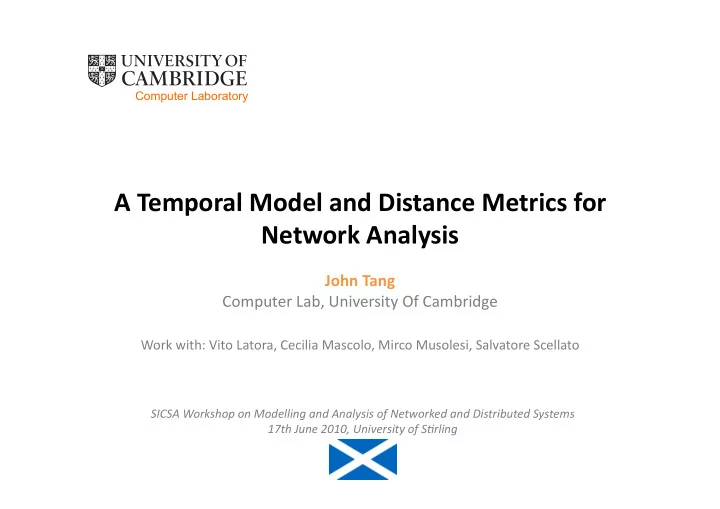

Computer Laboratory A Temporal Model and Distance Metrics for Network Analysis John Tang Computer Lab, University Of Cambridge Work with: Vito Latora, Cecilia Mascolo, Mirco Musolesi, Salvatore Scellato SICSA Workshop on Modelling and Analysis of Networked and Distributed Systems 17th June 2010, University of SFrling
Some Real Networks Computer Laboratory
Temporal Graph t=1 t=2 t=3 Computer Laboratory
Temporal Graph t=1 t=2 t=3 Computer Laboratory
Temporal Graph t=1 t=2 t=3 • StaJc • Shortest path (A,G) = [A,B,D,E,G] • Shortest path length (A,G) = 4 hops Computer Laboratory
Temporal Graph t=1 t=2 t=3 • StaJc • Shortest path (A,G) = [A,B,D,E,G] • Shortest path length (A,G) = 4 hops • Temporal • Shortest path (A,G) = [A,C,B,D,E,F,G] • Shortest path length (A,G) = 6 hops • Time=3 seconds Computer Laboratory
Temporal Metrics • Shortest Temporal Path Length d ij = d ∗ • Shortest Path with temporal constraints ij = E ij = 1 • Temporal Efficiency d ij Computer Laboratory
Temporal Metrics • Average Temporal 1 � L = ij d ij N ( N − 1) • Average Temporal 1 L ∗ = � ij d ∗ ij N ( N − 1) • Average Efficiency 1 � E glob = ij E ij N ( N − 1) Computer Laboratory
Does it really maXer? • Infocom 2005 conference environment • Bluetooth colocaJon scans • 5 Minute Windows • Measure 24 hours starJng 12am Sta<c Temporal Day N <k> Ac<vity L Eglob L* L Eglob Contacts 1 37 25.73 1.291 0.856 4.090 19h 39m 0.003 6pm‐12pm 3668 2 39 28.31 12am‐12pm 1.269 0.870 4.556 9h 6m 0.024 8357 3 38 22.32 12am‐12pm 4217 1.420 0.798 4.003 10h 32m 0.018 4 39 1.444 0.781 4.705 9h 55m 0.013 21.44 12am‐5pm 3024 Computer Laboratory
Temporal Small World • InvesJgate speed of evoluJon of temporal graphs vs. communicaJon efficiency • IntuiFon : Slowly evolving graphs should be slow for data communicaJon Computer Laboratory
StaJc SW Model • StaJc – High local clustering – Some nodes provide short cut links [WaXs&Strogatz 1998] Computer Laboratory
StaJc Clustering Coefficient 2 � j,k a jk � i C i C = C i = [( � j a ij ) ∗ (( � j a ij ) − 1)] N For all j, k such as a i,j = 1 and a j,k = 1 W metric the temporal-clustering coe ffi cient of C A = 2 / 3 Node i A B D C E F Computer Laboratory
StaJc Small World • Graphs which both are locally clustered but with small average delay – High local clustering => Lafce – Small average delay => Random Computer Laboratory
Temporal SW Model • N Random Walkers with Prob Jumping P j P j =0.0 � Computer Laboratory
Temporal SW Model • N Random Walkers with Prob Jumping P j P j =0.0 � P j =0.5 � Computer Laboratory
Temporal SW Model • N Random Walkers with Prob Jumping P j P j =0.0 � P j =0.5 � P j =1.0 � Computer Laboratory
Temporal CorrelaJon Coefficient T − 1 � j a ij ( t ) a ij ( t + 1) � 1 i C i � C = C i = T − 1 � N [ � j a ij ( t )][ � j a ij ( t + 1)] t =1 C A = 1 / 2 Node i A B Node i A B D C E F D C E F t1 t2 Computer Laboratory
Temporal Small World • Graphs which evolve slowly over Jme can sJll exhibit high communicaJon efficiency – Highly temporal‐clustering => non‐jumping model – Low temporal‐delay => fully‐jumping model Computer Laboratory
Small‐world Behaviour in Real Data C rand L rand E rand C L E α 0.44 0.18 3.9 (100%) 4.2 (98%) 0.50 0.48 0.40 0.17 6.0 (94%) 3.6 (92%) 0.41 0.45 β 0.48 0.13 12.2 (86%) 8.7 (89%) 0.39 0.37 γ Brain network δ 0.44 0.17 2.2 (100%) 2.4 (92%) 0.57 0.56 d1 0.80 0.44 8.84 (61%) 6.00 (65%) 0.192 0.209 d2 0.78 0.35 5.04 (87%) 4.01 (88%) 0.293 0.298 Bluetooth contacts d3 0.81 0.38 9.06 (57%) 6.76 (59%) 0.134 0.141 (INFOCOM’06) d4 0.83 0.39 21.42 (15%) 15.55(22%) 0.019 0.028 Mar 0.044 0.007 456 451 0.000183 0.000210 Jun 0.046 0.006 380 361 0.000047 0.000057 (London network) Sep 0.046 0.006 414 415 0.000058 0.000074 Dec 0.049 0.006 403 395 0.000047 0.000059 Computer Laboratory
Summary of Talk • Temporal Graphs & Distance Metrics – StaJc shortest paths overesJmate available hops and hence underesJmate shortest path length • Temporal Small World: – Contrary to intuiJon, slowly evolving graphs can be very efficient for data disseminaJon • Future Work – IdenJfying important nodes – Malware propogaJon • Best nodes for patching – Spectral Analysis Computer Laboratory
QuesJons? John Tang email jkt27@cam.ac.uk homepage www.cl.cam.ac.uk/~jkt27 twiGer @johnkiXang project hXp://www.cl.cam.ac.uk/research/srg/netos/ spa<altemporalnetworks Further Reading Small World Behavior in Time‐Varying Graphs, J. Tang, S. Scellato, M. Musolesi, C. Mascolo, V. Latora, Physical Review E, Vol. 81 (5), 055101, May 2010. Characterising Temporal Distance and Reachability in Mobile and Online Social Networks, J. Tang, M. Musolesi, C. Mascolo, V. Latora, ACM SIGCOMM Computer CommunicaJon Review (CCR). Vol. 40 (1), pp. 118‐124. Jan 2010. Temporal Distance Metrics for Social Network Analysis , J. Tang, M. Musolesi, C. Mascolo, V. Latora, In Proceedings of the 2nd ACM SIGCOMM Workshop on Online Social Networks (WOSN09). Aug 2009. Computer Laboratory
Recommend
More recommend